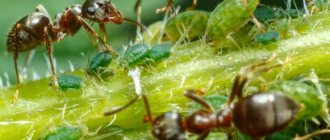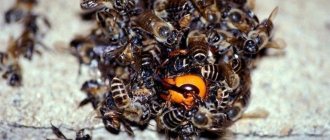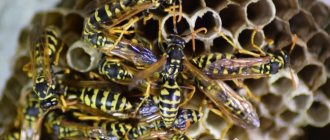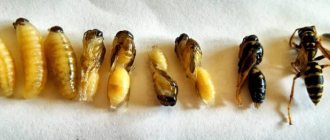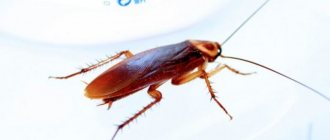What do hornets look like and why are they dangerous?
Externally, hornets are very similar to ordinary wasps, but they are very easy to distinguish by their large size. This insect can be described as follows:
- The body length depends on the specific subspecies, but the most common individuals are 3-5 cm, and their wingspan can be up to 7 cm.
- The body is striped and has a yellow-black color characteristic of this species.
- The abdominal cavity is most often dark brown.
- The head grows into the chest, this area is black.
These insects can pose a serious danger because their bites have the following features:
- Instant manifestation of an extremely acute allergic reaction and inflammatory processes , since the venom contains a large number of different substances and is close in composition to the venom of a rattlesnake.
- The hornet does not die after being bitten and is able to sting its target several more times.
- The bites are painful. According to various studies, only certain varieties of exotic ants are capable of stinging more painfully.
- Single individuals are capable of transmitting signals to their relatives at a distance , so in case of death or danger, help may arrive, and a person tolerates a large number of bites extremely poorly.
- People with various diseases have a hard time with bites , since they can negatively affect cardiac or respiratory activity, as well as many systems of the human body.
- If a child is bitten, internal organs may be damaged.
Ways to get rid of insects
Sometimes people and hornets can get along well, but in some situations the insects build their nests in undesirable places, posing a threat to others.
In such cases, you have to get rid of them; this can be done in different ways:
- Setting traps often cannot completely get rid of unwanted neighbors, but it allows you to destroy individual individuals that get too close to a person or territory where they should not be.
- The use of various chemicals, most often aerosols containing insecticides. This technique is one of the most effective, and it allows you to get rid of insects instantly. However, the use of insecticides also has a certain risk, since it may not be possible to destroy the hornets the first time, and such an attack will anger the inhabitants of the nest and provoke them to launch a counterattack.
- Call professionals from specialized services that deal with the destruction of all types of insects. This method is the most recommended, since it allows you to get not only a guaranteed result, but also protection from the reappearance of unwanted neighbors for a certain period of time. The only drawback of this option is the very high cost compared to other methods.
There are other ways to combat hornets, but the options discussed are the most popular, since other analogues are more dangerous. Regardless of the chosen method, they all boil down to one thing - the need to destroy the nest.
Hornet traps
A variety of hornet traps are very popular; stores today have a wide range of similar devices.
However, you can make them yourself; one of these options is discussed in detail below:
- Prepare a plastic bottle with a volume of at least 1.5 liters and cut off its top part with the neck.
- A fragrant bait is poured into the lower part, which will attract the attention of insects. You can use jam, honey or beer, and also mix these components with each other.
- The top of the bottle is inserted into the bottom, neck down. In this case, you must remember to remove the cover from it.
- As an additional measure, the neck can be lubricated with any oil, after which the trap will be ready. The hornets, flying towards the smell, will get caught inside, but will not be able to get out, since they will look for a way out exclusively along the side surfaces of the bottle. If some individuals get to the neck, they will not be able to get out due to the slippery coating on it.
This is due to the fact that the baits used will also attract the attention of bees, which will die along with the hornets.
How many hornets live in a nest?
The number of hornets in a nest depends on many factors and ranges from 400 to 600 individuals, although there are cases when the number of insects in one nest reached 1000.
Hornet larvae emerge from eggs laid by the female on the 5th...7th day. Their development lasts 10-15 days, ending at the pupal stage. After 1.5-2 weeks, a young individual emerges from the pupa. The colony reaches its maximum by the end of summer - beginning of autumn.
"House"
Locating the Nest
Regardless of the chosen method of destroying hornets, the first priority is to find their nest.
In some cases, this process does not take a significant amount of time or effort, and the nest can be found somewhere near the site, for example, in trees or in utility rooms; it is simply impossible not to notice it.
However, situations arise when the hornets’ home is securely hidden, and it is not possible to monitor where they are flying; in this case, you can use the old and proven method of determining the location of the nest:
- Hunt down one of the hornets and knock it down with a tennis
with a racket, and it is important not to kill him, but only to stun him. At the same time, care must be taken so that his relatives do not consider this a manifestation of aggression and go into an active attack. - Wear a thick leather or rubber glove on your hand to prevent the possibility of a dangerous bite.
- Take a long colored ribbon or thread and tie it around the stunned insect.
- Wait for the moment when the hornet comes to its senses. After this, he will go directly to the nest, and, thanks to the noticeable tape, it will be easy to track the trajectory of his flight.
First, you can try to wander around the area and try to locate the nest visually.
It is recommended to pay attention to the following places that these insects often choose to build their homes:
- Trees, especially if they have spreading branches that reliably hide the nest from prying eyes.
- Old stumps.
- Attics, sheds and various utility rooms , where people look extremely rarely and do not disturb these inhabitants.
- Under the roof of residential buildings.
- In holes dug in the ground. At the same time, the hornets themselves actually never create tunnels on their own; they use those that were made by other types of insects or underground animals.
Methods for destroying a nest
There are many ways to destroy a hornet’s home, but they are all associated with a certain danger, since these insects are ready to defend their nests to the last.
The following are the most common techniques:
- One of the oldest methods that people have long used is to immerse the nest in a container of water. In this case, you do not need to remove or touch it yourself; you need to place a bucket of water below so that the hive and its inhabitants are completely immersed in it. This option is best practiced indoors, since it often takes a lot of time to completely destroy a population, and the bucket can not be held by hand, but supported with a stepladder or other object.
- The simplest, most effective and favorite method by many is burning the nest, which is first doused with gasoline, kerosene or other flammable substances. The disadvantage is that this option is unsuitable for practical use near trees, wooden buildings, indoors and other places where a fire may occur.
- Spraying the inside of a sealed bag with any insecticide that poses a mortal danger to flying insects and wrapping it around the nest.
- Pouring liquid insecticide or water brought to a boil into holes that lead to underground hornet shelters. However, it must be taken into account that the tunnels can be very deep, so sometimes a very large volume of liquid is required.
- The easiest way to destroy nests that are located in tree hollows is to fill them with toxic substances or simply fill the hole with putty, after which the hornets will be walled up inside.
How to get rid of hornets in a country house under the roof of a house
How to get rid of hornets
The invasion of dangerous hymenoptera in residential premises and wooden buildings can be eliminated using two proven methods. The first is to clog the passages with foam. The method of use is described above.
The second way to deal with hornets in a country house under a roof indoors is to boil the swarm together with their house. Prepare in advance: a stepladder, a bucket, think about a mount for a bucket with liquid. The method is as follows. Boiling water is poured into a bucket or other deep container. Sometimes insecticides are added to boiling water. After this, the nest is immersed so that it is completely under water and fixed for a day. After 24 hours, the limp nest with all its inhabitants is thrown away.
Safety regulations
Regardless of the chosen method of getting rid of unwanted neighbors, you must remember how dangerous these insects can be, especially in large numbers.
For this reason, it is important to follow the following rules, which will increase the degree of human safety during the procedure:
- First of all, you need to choose the right clothes; they should be tight enough and not leave exposed areas of the body. Thick gloves are put on your hands, and your face should be protected with a special mesh mask, which is usually used by beekeepers.
- You should not make sudden movements or try to escape, even if the inhabitants of the nest go on the attack and try to sting your clothes. You need to calmly move to a safe distance.
- Prepare in advance all the necessary supplies that may be required to provide first aid : alcohol, ice, bandages, medications to reduce an allergic reaction.
- Do not use potentially dangerous methods of killing hornets , such as fire, if this can lead to negative consequences.
- There is no need to make noise near the nest so that its inhabitants do not find out ahead of time that uninvited guests have come to them.
- It is recommended to carry out removal only at night. However, even then the hornets do not sleep, they simply reduce their level of activity, but are ready to quickly mobilize if a threat arises.
In conclusion
Any method of destroying a nest is used exclusively in the evening or at night. It is a mistake to believe that then the hornets sleep. They have a 24/7 rhythm of life. He's just not as active in the evening and at night. Therefore, there is no need to lose vigilance. Use the flashlight very selectively. Insects are very responsive to sudden changes in lighting. All radical measures against hornets must be justified. Nests should be destroyed only when the hymenoptera truly pose a threat to humans, bees or crops. In other cases, it is better to be in peaceful coexistence with them. After all, in some countries “large wasps” have long been listed in the Red Book.
Source
Calling specialists
This method of exterminating hornets is the safest, since the employees of the selected organization will do all the work themselves.
This option has several features that need to be taken into account:
- Today there are a lot of companies specializing in insect control , so it is recommended not to rush into making a choice, but to compare different options based on criteria such as pricing policy and customer reviews.
- Discuss important nuances, including guarantees that insects will not appear again. This information must be included in the contract, which is concluded in writing.
- The problem of removing hornets is more typical for suburban areas, and this is one of the criteria that affects the price of the service. Typically, the farther from the city the place where the nest needs to be destroyed is located, the higher the price for this procedure.
Physical methods of dealing with hornets
- Homemade traps from plastic bottles. An incision in the shape of a cross is made on the lid. The cut areas are bent inwards. You need to put bait in the bottle in the form of a piece of sugar, a couple of drops of kvass or other sweets. The hornet will get inside the bottle without any problems, but will not be able to get out. Similarly, you can make a trap from a bottle like this: cut it in half, turn the half with the neck back and insert it back. Place bait inside. All.
- Fire. It should only be used away from wooden buildings and if there is no risk of fire. Remember that fire in a summer cottage and in the forest spreads very quickly. To destroy a nest, just put a piece of burning paper or rag inside.
- Vacuum cleaner. Surprisingly, this is also a completely working method. Simply place the end of the suction hose inside the socket. It is better to use a bag vacuum cleaner so that after catching insects, you can destroy the bag using this method. A container type vacuum cleaner is also suitable, but after the procedure you will need to wait 2-3 days for the hornets to die.
( Video : “Hornets and the giant cocoon”)
Prevention of hornets
You cannot do without preventive measures if hornets build nests on your site every season. The following work will help prevent the establishment of nests of these dangerous insects:
- Remove old nests in late fall. Try to seal all the cracks and holes in the roof of the house and plumbs so that insects cannot overwinter in it. Doors and windows should also be closed as tightly as possible.
- Remove nests in the spring, when first discovered . A large colony has not yet appeared in the spring, so try to find and destroy it as early as possible. Timely destruction will protect against these insects for the entire season.
- If you are the owner of an apiary, then you should pay all your attention to the appearance of hornets . Having noticed sexually mature females that are beginning to sculpt the first honeycombs, it is necessary to immediately take measures to destroy them. Otherwise, the hornets are capable of destroying the bee colony.
- Traps for queen hornets. Reproduction of the colony depends primarily on the queens. Therefore, if you catch them, then no reproduction of the hornets will occur. The trap recipe is to fill a bucket of water and add bait (sweet or sour, it doesn’t matter). Add soap solution or dish detergent. Having arrived at the smell of bait, the queen will want to try it, but once inside the liquid she will no longer be able to get out of it.
- Traps made of plastic bottles with bait. Hang baited traps on the trees around the area; in the spring, when the queens wake up, they will definitely fall into one and the appearance of a nest will be avoided.
All the options listed above will help avoid the appearance of colonies in the spring, when the hornets begin to actively live. If during this period you manage to protect the site and house from the creation of a nest, then in the summer the probability of its appearance drops sharply, since the insects have already decided on their place of residence.
First aid for insect bites
If the hornet still managed to sting a person, then you need to act extremely quickly and not waste time in order to avoid possible complications.
Providing first aid consists of the following actions:
- Suctioning venom from the stung area. This procedure must be carried out immediately, since its effect will only be for a short time after the bite, before the poison has time to spread. This will not completely prevent all consequences and get rid of an allergic reaction, but it will significantly minimize the risk.
- Apply ice or any fairly cold compress to the bite site, which will reduce pain and prevent the growth of the lesion.
- Do not touch the affected area and do not allow the bitten person to do so, since any rubbing and scratching will stimulate blood circulation, which will ensure the spread of poison throughout the body, not to mention the possibility of infection, which can significantly aggravate the situation. There is also no need to try to detect the sting, since hornets, unlike bees, never leave it at the site of the bite. This is due to the peculiarity of the structure of their poisonous weapon, which has a smooth surface.
- Use any method to disinfect the affected area; for this you can use hydrogen peroxide, medical alcohol or other disinfectants. You need to treat the bite area with extreme caution, without pressing on it.
- You can apply wet sugar to the bite, which is then wrapped in a bandage or towel. This will allow you to draw out a certain amount of toxic substances that did not have time to spread throughout the body. You can remove the bandage after 10 minutes, since this time is enough to draw out the poison.
- Apply a swab heavily moistened with citric acid or vinegar to the bite site, this will reduce inflammation and an allergic reaction. This reaction occurs due to the fact that the toxic substances that the hornet uses are alkalis, and vinegar and citric acid can destroy their structure.

